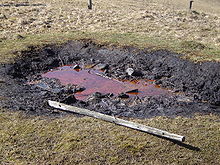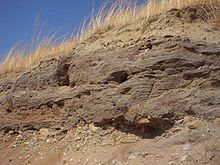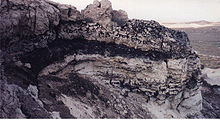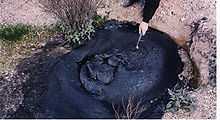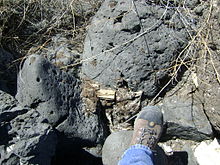- Petroleum seep
-
- For other uses of "seep" see Seep (disambiguation)
A petroleum seep is a place where natural liquid or gaseous hydrocarbons escape to the earth's atmosphere and surface, normally under low pressure or flow. Seeps generally occur above either terrestrial or offshore petroleum accumulation structures.[1] The hydrocarbons may escape along geological layers, or across them through fractures and fissures in the rock, or directly from an outcrop of oil-bearing rock.
Petroleum seeps are quite common in such areas of the world and have been known and exploited by mankind since paleolithic times. Natural products associated with these seeps include bitumen, pitch, asphalt and tar. The occurrence of petroleum was often included in location names that developed; these locations are also associated with early exploitation as well as scientific and technological developments, which have grown into the petroleum industry.
Contents
Ancient knowledge and finds
The exploitation of bituminous rocks and natural seep deposits dates back to paleolithic times. The earliest known use of bitumen was by Neanderthals, some 40,000 years ago; bitumen has been found adhering to stone tools used by Neanderthals at sites in Syria. After the arrival of Homo sapiens, humans used bitumen for construction of buildings and water proofing of reed boats, among other uses.[2] The use of bitumen for waterproofing and as an adhesive dates at least to the third millennium BCE in the early Indus community of Mehrgarh where it was used to line the baskets in which they gathered crops.[3] The material was also used it as early as the third millennium BCE in statuary, mortaring brick walls, waterproofing baths and drains, in stair treads, and for shipbuilding. According to Herodotus, and confirmed by Diodorus Siculus, more than four thousand years ago natural asphalt was employed in the construction of the walls and towers of Babylon; there were oil pits near Ardericca (near Babylon), as well as a pitch spring on Zacynthus (Ionian islands, Greece).[4] Great quantities of it were found on the banks of the river Issus, one of the tributaries of the Euphrates. In ancient times, bitumen was primarily a Mesopotamian commodity used by the Sumerians and Babylonians, although it was also found in the Levant and Persia. Along the Tigris and Euphrates rivers, the area was littered with hundreds of pure bitumen seepages. The Mesopotamians used the bitumen for waterproofing boats and buildings. Ancient Persian tablets indicate the medicinal and lighting uses of petroleum in the upper levels of their society. In ancient Egypt, the use of bitumen was important in creating Egyptian mummies—in fact, the word mummy is derived from the Arab word mūmiyyah, which means bitumen.[2] Oil from seeps was exploited in the Roman province of Dacia, now in Romania, where it was called picula.
In East Asia these locations were known in China, where the earliest known drilled oil wells date to 347 AD or earlier.[5] The ancient records of China and Japan are said to contain many allusions to the use of natural gas for lighting and heating. Petroleum was known as burning water in Japan in the 7th century.[4] In his book Dream Pool Essays written in 1088, the polymathic scientist and statesman Shen Kuo of the Song Dynasty coined the word 石油 (Shíyóu, literally "rock oil") for petroleum, which remains the term used in contemporary Chinese.
In southwest Asia The first streets of 8th century Baghdad were paved with tar, derived from natural seep fields in the region. In the 9th century, oil fields were exploited in the area around modern Baku, Azerbaijan. These fields were described by the Arab geographer Abu al-Hasan 'Alī al-Mas'ūdī in the 10th century, and by Marco Polo in the 13th century, who described the output of those wells as hundreds of shiploads. Petroleum was distilled by the Persian alchemist, Muhammad ibn Zakarīya Rāzi (Rhazes), in the 9th century,[6] producing chemicals such as kerosene in the alembic (al-ambiq),[7] and which was mainly used for kerosene lamps.[8] Arab and Persian chemists also distilled crude oil in order to produce flammable products for military purposes. Through Islamic Spain, distillation became available in Western Europe by the 12th century.[9] It has also been present in Romania since the 13th century, being recorded as păcură.[10]
In Europe, they were extensively mined near the Alsace city of Pechelbronn, where the vapor separation process was in use in 1742[11] In Switzerland about 1710, the Russian-born Swiss physician and Greek teacher Eyrini d'Eyrinis discovered asphaltum at Val-de-Travers, (Neuchâtel). He established a bitumen mine de la Presta there in 1719 that operated until 1986.[12][13][14][15] Oil sands here were mined from 1745 under the direction of Louis Pierre Ancillon de la Sablonnière, by special appointment of Louis XV.[16] The Pechelbronn oil field was active until 1970, and was the birth place of companies like Antar and Schlumberger. In 1745 under the Empress Elisabeth of Russia the first oil well and refinery were built in Ukhta by Fiodor Priadunov. Through the process of distillation of the "rock oil" (petroleum) he received a kerosene-like substance, which was used in oil lamps by Russian churches and monasteries (though households still relied on candles).[17]
The earliest mention of petroleum seeps in the Americas occurs in Sir Walter Raleigh's account of the Pitch Lake on Trinidad in 1595; while thirty-seven years later, the account of a visit of a Franciscan, Joseph de la Roche d'Allion, to the oil springs of New York was published in Sagard's Histoire du Canada. In North America, the early European fur traders found Canadian First Nations using bitumen from the vast Athabasca oil sands to waterproof their birch bark canoes.[18] A Finnish born Swedish scientist, Peter Kalm, in his work Travels into North America published first in 1753 showed on a map the oil springs of Pennsylvania.[4] In 1769 the Portolà expedition, a group of Spanish explorers led by Gaspar de Portolà, made the first written record of the tar pits in California. Father Juan Crespi wrote, "While crossing the basin the scouts reported having seen some geysers of tar issuing from the ground like springs; it boils up molten, and the water runs to one side and the tar to the other. The scouts reported that they had come across many of these springs and had seen large swamps of them, enough, they said, to caulk many vessels. We were not so lucky ourselves as to see these tar geysers, much though we wished it; as it was some distance out of the way we were to take, the Governor [Portola] did not want us to go past them. We christened them Los Volcanes de Brea [the Tar Volcanoes]."[19]
More modern associations
The modern history of petroleum exploitation, originally from seeps began in the 19th century with the refining of kerosene from crude oil as early as 1823, and the process of refining kerosene from coal by Nova Scotian Abraham Pineo Gesner in 1846; but it was only after Ignacy Łukasiewicz had improved Gesner's method to develop a means of refining kerosene from the more readily available "rock oil" ("petr-oleum") seeps, in 1852, that the first rock oil mine was built near Krosno in central European Galicia (Poland/Ukraine) in 1853. In 1854, Benjamin Silliman, a science professor at Yale University, was the first American to fractionate petroleum by distillation. These discoveries rapidly spread around the world,
The world's first commercial oil well was drilled in Poland in 1853, and the second in nearby Romania in 1857. At around the same time the world's first, but small, oil refineries were opened at Jasło, in Poland, with a larger one being opened at Ploiești, in Romania, shortly after. Romania is the first country in the world to have its crude oil output officially recorded in international statistics, namely 275 tonnes.[20][21] By the end of the 19th century the Russian Empire, particularly in Azerbaijan, had taken the lead in production.[22]
The first oil "well" in North America was in Oil Springs, Ontario, Canada in 1858, dug by James Miller Williams. The US petroleum industry began with Edwin Drake's drilling of a 69-foot (21 m) oil well in 1859,[23] on Oil Creek near Titusville, Pennsylvania, both named for their petroleum seeps.
Other sources of oil, initially associated with petroleum seeps were discovered in Peru (1863), in Zorritos District, in the Dutch East Indies (1885), on Sumatra, in [[Persia (1908), at Masjed Soleiman, as well as in Venezuela, Mexico, and the province of Alberta, Canada.
By 1910, these too were being developed at an industrial level. Initially these petroleum sources and products were for use in fueling lamp, but with the development of the internal combustion engine, their supply could not meet the increased demand; many of these early traditional sources and "local finds" were soon outpaced by technology and demand.
California seeps
California has thousands of naturally occurring seeps. Much of the petroleum discovered in California during the 19th century was from observations of seeps.[24] The world's largest natural oil seepage is Coal Oil Point in the Santa Barbara Channel, California. Three of the better known tar seep locations in California are McKittrick Tar Pits,[25] Carpinteria Tar Pits and the La Brea Tar Pits.[26]
At Kern River Oil Field, there are no active seeps. However, oil stained formations in outcrop remain from previously active seeps.
Petroleum seeps may be a significant source of pollution.
McKittrick seeps
In McKittrick Oil Field in western Kern County, there are numerous seeps. Some of the seeps flow into drainages that drain toward the San Joaquin Valley floor.
The McKittrick seeps were mined for asphalt by the native Americans, and in the 1870s, larger scale mining was undertaken by means of both open pits and shafts. In 1893, Southern Pacific Railroad constructed a line to Asphalto, 2 miles from present day McKittrick. Fuel oil for the railroad was advantageous, especially since there are very few coal bearing formations in California.[27] The field is produced now by conventional oil wells, as well as by steam fracturing.
The oil seeps at McKittrick are located in diatomite formation that has been thrust faulted over the younger sandstone formations. Similarly, in the Upper Ojai Valley in Ventura County, tar seeps are aligned with east-west faulting. In the same area, Sulphur Mountain is named for the hydrogen sulfide-laden springs. The oilfields in the Sulphur Mountain area date from the 1870s. Production was from tunnels dug into the face of a cliff, and produced by gravity drainage.[28]
Offshore seeps
In the Gulf of Mexico, there are more than 600 natural oil seeps that leak between five and one million barrels of oil per year - roughly 4k to 200k tonnes.[29] When a petroleum seep forms underwater it may form a peculiar type of volcano known as an asphalt volcano.
The California Division of Oil, Gas and Geothermal Resources published a map of offshore oil seeps from Point Aguello (north of Santa Barbara) to Mexico.[30] In addition, they published a brochure describing the seeps. The brochure also discusses the underground blowout at Platform A which caused the 1969 Santa Barbara oil spill. It also describes accounts from divers, who describe seepage changes after the 1971 San Fernando earthquake.[31]
In Utah, there are natural oil seeps at Rozel Point on the Great Salt Lake.[32] The oil seeps at Rozel Point can be seen when the lake level drops below an elevation of approximately 4198 feet; if the lake level is higher, the seeps are underwater. The seeps can be found by going to the Golden Spike historical site, and from there, following signs for the Spiral Jetty. Both fresh tar seeps and re-worked tar (tar caught by the waves and thrown up on the rocks) are visible at the site.
The petroleum seeping at Rozel Point is high in sulfur, but has no hydrogen sulfide.[33] This may be related to deposition in an hypersaline lacustrine environment.[34]
See also
References
- ^ Scientists Find That Tons Of Oil Seep Into The Gulf Of Mexico Each Year NASA/Goddard Space Flight Center--EOS Project Science Office. 27 January 2000.
- ^ a b Hirst, K. Kris (2009). "Bitumen - A Smelly but Useful Material of Interest". Archaeology. About.com. http://archaeology.about.com/od/bcthroughbl/qt/bitumen.htm. Retrieved 2009-10-23.
- ^ McIntosh, Jane. The Ancient Indus Valley. p. 57
- ^ a b c
 This article incorporates text from a publication now in the public domain: Chisholm, Hugh, ed (1911). "Petroleum". Encyclopædia Britannica (11th ed.). Cambridge University Press.
This article incorporates text from a publication now in the public domain: Chisholm, Hugh, ed (1911). "Petroleum". Encyclopædia Britannica (11th ed.). Cambridge University Press. - ^ ASTM timeline of oil
- ^ Salim Al-Hassani (2008). "1000 Years of Missing Industrial History". In Emilia Calvo Labarta, Mercè Comes Maymo, Roser Puig Aguilar, Mònica Rius Pinies. A shared legacy: Islamic science East and West. Edicions Universitat Barcelona. pp. 57–82 [63]. ISBN 8447532852.
- ^ Ajram (1992), p. ?.
- ^ Zayn Bilkadi (University of California, Berkeley), "The Oil Weapons", Saudi Aramco World, January–February 1995, pp. 20-7
- ^ Joseph P. Riva Jr. and Gordon I. Atwater. "petroleum". Encyclopædia Britannica. http://www.britannica.com/EBchecked/topic/454269/petroleum. Retrieved 2008-06-30.
- ^ Istoria Romaniei, Vol II, p. 300, 1960
- ^ "Pechelbronn petroleum museum" (in (French)). http://www.musee-du-petrole.com/page14.htm.
- ^ (broken link) Muséum d'histoire naturelle, Geneva. accessed 2007-10-26
- ^ Le bitume et la mine de la Presta (Suisse), Jacques Lapaire, Mineraux et Fossiles No 315
- ^ "Asphaltum" Stoddart's Encyclopaedia Americana (1883) pages 344–345
- ^ Eirinis' paper, entitled "Dissertation sur la mine d'asphalte contenant la manière dont se doivent régler Messieurs les associés pour son exploitation, le profit du Roy, & celui de la Société, & ce qui sera dû à Mr d'Erinis à qui elle apartient 'per Ligium feudum' " is held at the BPU Neuchâtel - Fonds d'étude [Ne V] catalogue
- ^ History of Pechelbronn oil
- ^ http://www.nepsite.com/node/5944
- ^ Mackenzie, Sir Alexander (1970). Lamb, W. Kaye. ed. The Journals and Letters of Alexander Mackenzie. Cambridge: Hakluyt Society. p. 129. ISBN 0521010349
- ^ Kielbasa, John R. (1998). "Rancho La Brea". Historic Adobes of Los Angeles County. Pittsburg: Dorrance Publishing Co.. ISBN 0-8059-4172-X. http://www.laokay.com/halac/RanchoLaBrea.htm..
- ^ The History Of Romanian Oil Industry
- ^ PBS: World Events
- ^ Akiner, Shirin; Aldis, Anne, ed (2004). The Caspian: Politics, Energy and Security. New York: Routledge. ISBN 978-0-7007-0501-6., p. 5
- ^ John Steele Gordon "10 Moments That Made American Business", American Heritage, February/March 2007.
- ^ Natural Oil and Gas Seeps in California.
- ^ McKittrick Tar Seeps. Buena Vista Museum Of Natural History.
- ^ La Brea Tar Pits. Page Museum.
- ^ McKittrick Oil Field, article by R.L. Hewitt, Trico Oil and Gas Company, in AAPG/SEPM/SEG Guidebook, Joint Annual Meeting, Los Angeles, California, March 1952, Boris Laiming, The Texas Company, Editor.
- ^ Piru to Ojai Road Log, by J.W. Sheller, State Exploration Company, in AAPG/SEPM/SEG Guidebook, Joint Annual Meeting, Los Angeles, California, March 1952, Boris Laiming, The Texas Company, Editor.
- ^ Oil in the Sea III: Inputs, Fates, and Effects. 2003.
- ^ [1]. California Offshore Oil and Gas Seeps Map
- ^ [2] California Offshore Oil and Gas Seeps Map
- ^ Geosights, Spiral Jetty. Utah Geological Survey.
- ^ T.F. Yen and G.V. Chiligarian, editors, Asphaltenes and Asphalts, volume 1, Elsevier Science B.V, 1994. Page 302.
- ^ Guoying Sheng, Jiamo Fu, S. C. Brassell, A. P. Gowar, G. Eglinton, Jaap S. Sinninghe Damste, Jan W. de Leeuw and P. A. Schenck, Sulphur-containing compounds in sulphur-rich crude oils from hypersaline lake sediments and their geochemical implications, in Chinese Journal of Geochemistry. Published by Science Press, co-published with Springer-Verlag GmbH, 1987-04-01.
- Hornafius, J.S.Quigley, D.C., and Luyendyk, B.P. "The world's most spectacular marine hydrocarbon seeps (Coal Oil Point, Santa Barbara Channel, California): Quantification of Emissions", Journal of Geophysical Research, v.104, n. C9, pp. 20,703-20,711, September 15, 1999. [3]
Categories:- Asphalt lakes
- Petroleum geology
- Economic geology
- Petroleum
Wikimedia Foundation. 2010.

